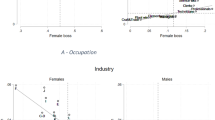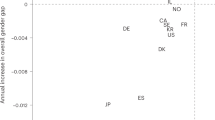Abstract
This paper uses data from the National Longitudinal Survey of Youth, 1979 (NLSY79) and the Current Population Survey to estimate the wage effects of having a female supervisor. Existing studies, using OLS to estimate the supervisor gender effect, find wage penalties for both men and women associated with working for a female supervisor. We extend this research in two important ways. First, we control for gender segregation at job level as opposed to the broader occupation level. This is important because of the concern that supervisor gender is simply a proxy for the gender-type of the job. Second, we apply fixed effects estimation to control for selection effects of supervisor gender. When using OLS we find estimates of the supervisor gender effect similar to those in the existing literature. However, when using fixed effects we find no evidence of a supervisor gender effect for women and only a small, marginally significant effect for men. We conclude that existing OLS estimates overstate the importance of the impact of supervisor gender on wages.
Similar content being viewed by others
Notes
Cardoso and Winter-Ebmer (2010) is arguably an exception to this in that they find that women receive a wage premium when working in “female-led” firms. But, as discussed below, they do not present evidence on the relationship between wages and the gender of the direct supervisor of the worker.
In their model, “type” is interpreted broadly to mean gender, ethnicity, personality type, and so on. In this paper, we focus on gender types.
For those respondents who had no supervisory duties, co-worker proportion female \(=\) (number of women supervised by R’s supervisor)/(total number of workers under R’s supervisor). For those respondents who also supervised others, co-worker proportion female \(=\) (number of women supervised by R’s supervisor \(+\) number of women R supervised)/(total number of workers under R’s supervisor \(+\) total supervised by R).
This variable provides an indication of the degree of sex segregation within firms. About 72 % of women’s co-workers are women, while only about 22 % of men’s co-workers are women. For all workers with female supervisors, co-workers are 76 % women.
All analyses reported in this paper were also conducted using a sample that includes both workers with supervisors as well as those without supervisors. Our findings are unaffected by the inclusion of unsupervised workers.
Rothstein (1997) also considers the effect of supervisor gender on promotion when these respondents were much younger. She finds an insignificant relationship for both men and women. But she did not use a direct measure of turnover. Rather her outcome variable was the person’s “perceived likelihood” of promotion.
The Armed Services Vocational Aptitude Battery (ASAB) was administered in 1980, when NLSY79 subjects ranged in age from fifteen-23. The AFQT is derived sections of the ASVB. Our measure of AFQT is the standardized fitted value of AFQT from a regression of AFQT on a vector of age indicator variables.
We follow Rothstein by choosing the 60 % cut-off. Since this choice is arbitrary, in unreported regressions we also used the percent female in the three-digit occupation and industry. Conclusions are unaffected.
Reported point estimates use the transformation \(100\cdot (\text{ exp } ({\hat{\gamma }})-1)\).
We use a Stata program written by Cameron, Gelbach and Miller for implementing their method (http://personal.anderson.ucla.edu/judson.caskey/data.html).
Results from these specifications are available on request.
Hausman tests also indicate that FE is the preferred specification for these panel data.
References
Athey S, Avery C, Zemsky P (2000) Mentoring and diversity. Am Econ Rev 90:765–786
Babcock L, Laschever S (2003) Women don’t ask. Princeton University Press, Princeton
Bayard K, Hellerstein J, Neumark D, Troske KR (2003) New evidence on sex segregation and sex differences in wages from matched employee-employer data. J Labor Econ 21:887–922
Blau FD, DeVaro J (2007) New evidence on gender differences in promotion rates: an empirical analysis of a sample of new hires. Ind Relat 46:511–550
Cameron AC, Gelbach JB, Miller DL (2006) Robust inference with multi-way clustering Technical Working Paper No. 327. National Bureau of Economic Research, Cambridge
Canton E, Verheul I (2009) Gender pay differences in the European Union: do higher wages make up for discrimination? RRIM Report Series Reference No. ERS-2009-041-ORG January 2009
Cardoso AR, Winter-Ebmer R (2010) Female-led firms and gender wage policies. Ind Labor Relat Rev 64:143–163
Carneiro P, Heckman JJ, Masterov DV (2005) Labor market discrimination and racial differences in premarket factors. J Law Econ 48:1–39
Carrington WJ, Troske KR (1998) Sex segregation in U.S. manufacturing. Ind Labor Relat Rev 51:445–64
Ferber MA, Green CA (1991) Occupational segregation and the earnings gap: further evidence. In: Hoffman EP (eds) Essays on the economics of discrimination. WE Upjohn Institute for Employment Research, Kalamazoo, MI, pp 145–165
Gneezy U, Niederle M, Rustichini A (2003) Performance in competitive environments: gender differences. Q J Econ 118:1007–1047
Heckman JJ, Stixrud J, Urzua S (2006) The effects of cognitive and noncognitive abilities on labor market outcomes and social behavior. J Labor Econ 24:441–482
Hultin M, Szulkin R (1999) Wages and unequal access to organizational power: an empirical test of gender discrimination. Admin Sci Quart 44:453–472
Hunt J, von Restorff C-H (2004) Wasted resources in Germany: The paucity of female supervisors and the wage disadvantage of their subordinates. Published as ”Ressourcenverschwendung in Deutschland: Die geringe Anzahl weiblicher Vorgesetzter und die Lohneinbussen ihrer Mitarbeiter”. In Bernd Fitzenberger, Werner Smolny and Peter Winker (eds). Herausforderungen an den Wirtschaftsstandort Deutschland Baden-Baden: Nomos Verlagsgesellschaft
Johnson NB, Scandura TA (2004) The effect of mentorship and sex-role style in male-female earnings. Ind Relat 33:263–274
Lang K (1986) A language theory of discrimination. Q J Econ 101:363–282
Melero E (2004) Sex differences in managerial style: from individual leadership to organizational labour relationships. IZA DP No. 1387, November, 2004
Niederle M, Vesterlund L (2007) Do women shy away from competition? Do men compete too much? Q J Econ 122(3):1067–101
Ostroff C, Atwater L (2003) Does whom you work with matter? Effects of referent group gender and age composition on manager’s compensation. J Appl Psychol 4:725–740
Rothstein DS (1997) Early career supervisor gender and the labor market outcomes of young women. In: Blau FD, Ehrenberg RG (eds) Gender and family issues in the workplace. Russell Sage Foundation, New York, pp 210–255
Author information
Authors and Affiliations
Corresponding author
Rights and permissions
About this article
Cite this article
Sicilian, P., Grossberg, A.J. Does supervisor gender affect wages?. Empir Econ 46, 479–499 (2014). https://doi.org/10.1007/s00181-013-0695-4
Received:
Accepted:
Published:
Issue Date:
DOI: https://doi.org/10.1007/s00181-013-0695-4




